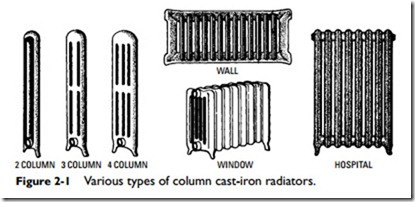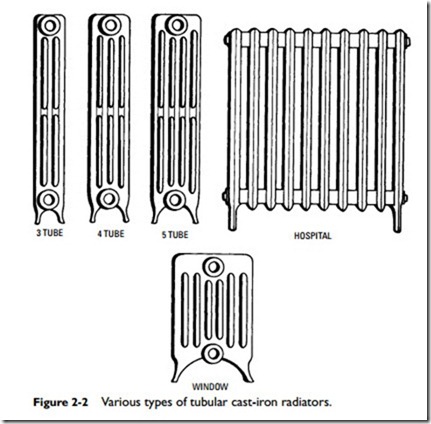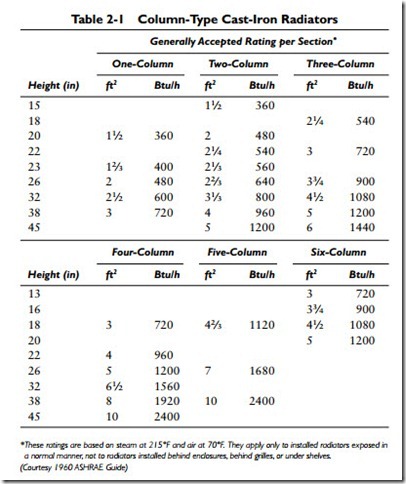The two basic methods by which heat-emitting units transfer heat to their surroundings are (1) radiation and (2) convection. Radiation is the transmission of thermal energy by means of electromagnetic rays. In other words, an object is warmed by heat waves radiating from a hot surface. Convection is the transfer of heat by natural or forced movement (circulation) of the air across a hot surface. In actual practice, heat-emitting units will transfer heat partially by radiation (up to 30 percent) and partially by convection (70 to 90 percent).
The output of heat-emitting units is expressed in terms of Btu per hour (Btu/h), in square feet of equivalent direct radiation (EDR), or in 1000 Btu per hour (MB/h). The required radiation of an installation is determined on the basis of the Btu-per-hour capacity of each heat-emitting unit. See Determining Required Radiation in this chapter.
The selection of a heat-emitting unit will depend on the type of heating system, the cost, the required capacity, and the application. For example, electric unit heaters should be used only where the cost of electricity is especially low. These heaters are generally associated with high operating costs. On the other hand, they are relatively inexpensive, and their installation cost is low because no separate piping or boiler is required. Each type of heat-emitting unit will have similar advantages and disadvantages that you must carefully consider before choosing the type most suited for the installation.
The principal types of heat-emitting units used in heating systems are:
1. Radiators
2. Convectors
3. Baseboard heaters
4. Kickspace heaters
5. Floor and window recessed heaters
6. Unit heaters
cast-iron radiator is a heat-emitting unit that transmits a portion of its heat by radiation and the remainder by convection. An exposed radiator (or freestanding radiator) transmits approximately half of its heat by radiation, the exact amount depending on the size and number of the sections. The balance of the emission is by conduction to the air in contact with the heating surface, and the resulting circulation of the air warms by convection.
Cast-iron radiators have been manufactured in both column and tubular types (see Figures 2-1 and 2-2). Column and large-tube radiators (with 21⁄2-inch spacing per section) have been discontinued. The small-tube radiator with spacings of 13⁄4 inches per section is now the prevailing type. Ratings for various cast-iron radiators are given in Tables 2-1, 2-2, and 2-3, courtesy of the American Society of Heating, Refrigerating, and Air-Conditioning Engineers.
As shown in Figure 2-1, each radiator section has 11⁄4-inch- diameter openings located at the top and bottom on each side. These openings (called waterways in hot-water radiators) are the passages through which the steam or hot water flows between the radiator sections. Round metal fittings are installed in these openings to join the sections together when forming a larger radiator module.
The radiators used in modern steam and hot-water heating systems are designed with nipples located in both the upper and lower portions of each radiator section, but this was not always the case with steam radiators. The earliest cast-iron steam radiators used in the old one-pipe steam heating systems were produced
with nipples located only in the bottom portion of each section. This was done because steam is light and rises quickly in the radiator, pushing air ahead of it. The air is expelled through an air vent located near the top of the radiator; the steam returns to the bottom of the same radiator section and then moves through the nipple to the adjoining section. Hot-water cast-iron radiators, on the other hand, require nipples at both the top and bottom of each section to improve water circulation. Hot water is heavier than steam and will not move as quickly without the assistance of two sets of nipples.
Wall and window radiators are cast-iron units designed for specific applications. Wall radiators are hung on the wall and are especially useful in installations where the floor must remain clear for cleaning or other purposes. They may consist of one or more
flat wall radiator sections. Window radiators are located beneath a window on an exterior wall. The heat radiating from the surface of the unit provides a very effective barrier against drafts.


